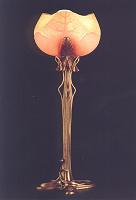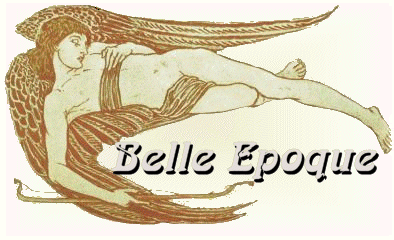The Belle Epoque in Europe
France
École de Nancy (The Nancy School)

Before Lorraine became a french province in 1766, Nancy had been the capital of the duchy, as much characterized by its impressing buildings of the Middle Age as by its Renaissance palaces and its splendid Baroque edifices built by the exiled Polish king Stanislas who was the father-in-law of Louis XV and the last duke of Lorraine, having had determinative influence on the appearance of Nancy up to our days.
The military and human catastrophe of France after the French-German war of 1870/71, having lost the whole Alsace and a great part of Lorraine, led for Nancy, suddenly being a town at the German border, at the end of the XIXth century to an economical, scientific and cultural boom never known before. Many inhabitants of Alsace and Lorraine left their native country which now was German and took refuge in the ancient capital; the number of inhabitants doubled to 100,000 and made of Nancy a prosperous city which still attracted more people to live there. As a consequence, new houses and quarters were built, Nancy saw an intense commercial life of shops and big stores, the establishment of industry, offices and banks. The district of Meurthe-et-Moselle became a rich country thanks to the foundation of new iron mines and the development of the metallurgy; the manufacturing industry, especially the metal industry and coppersmiths, saw a boom as much exceptional as for the traditional industries in the periphery, the breweries, the tanneries, the glaziers and the glass-blowers. Under these economic conditions flourished an intellectual life and an artistic movement without precedent.
The people of Alsace living in exile also influenced the reputation of the universities and the high schools; e. g. Théodore Devilly from Metz, director of the Ecole municipale de dessin (Municipal school of design) in Nancy, reformed the subjects of instruction and already focussed the students attention to the shapes of nature. Moreover, with regard to the requirements of the regional industry, he trained artists having a knowledge of technique. The return to nature was also the preoccupation of Emile Gallé (1846-1904) who wanted to liberate the decorative arts from all influence of historic styles. In 1884 already, in Paris, at the exposition of the Union centrale des arts décoratifs, he caused a stir, but it was only in 1894 that in the capital of Lorraine took place an exposition of decorative and industrial art where for the first time a part was dedicated to architecture. The cabinetmaker Eugène Vallin (1856-1922) displayed the draft of the splendid dining room ceiling of the house he started to build for himself in 1895 in the boulevard Lobau which has to be considered as one of the first manifestations of Art Nouveau in Nancy.

In 1901, the movement, meanwhile appreciated and productive, institutionalized by the foundation of the Alliance provinciale des industrie d'art known as Ecole de Nancy which nonetheless devoted little to creative architecture. It was only in 1904 that a second exposition conceded wide space to the architects. But the economic and artistic force did not lead to a determinate urban development since the municipal authorities left the initiative to the private sector. In 1904 only, the construction of large axes connecting the suburbs with the city started. Between 1891 and 1991, 3,500 new houses have been built, but only 250 were influenced by the Art Nouveau which nevertheless was more than in most other European cities at the time. The architects, the engineers and the industrialists distributed the market between each other. Most of the architects came from the Ecole nationale des Beaux-Arts of Paris and preferred the classical tradition. In return, the engineers like Henri Gutton (1851-1933) introduced new techniques and materials contributing in this way to the renewal of shapes. But the highest merit is due to the cabinetmaker Eugène Vallin who totally broke with traditional techniques: "Construction has to correspond to its destination and its material, the execution has to be as simple, as logical as possible. Such a sane construction must not be concealed by nothing, it has to remain evident (...). Modern decoration, shaped by nature's model, reveals the construction. Its design conceals as little as possible, just the connecting pieces, the seams."
This was the declaration of war to the traditionalist architects of Nancy, but the construction of the Villa Majorelle, in the beginning of the century, by the Parisian Henri Sauvage (1873-1932) gave not the supposed example. This masterpiece of the new art did at first not find imitators, only the executive architect Lucien Weissenburger (1860-1929) drew the conclusions from it. While the traditionalist architects of Nancy strengthened the decline of the historic styles by adding regional elements, Emile André (1871-1933), the most brilliant of them, liberated himself completely from these influences. More than any other, he knew how to utilize the great diversity of the available materials.

In the quarries of Euville, not far from Commercy in the district of the Meuse, a whitish limestone of excellent quality could be found. The everywhere present polychromy was strengthened by the use of bricks and decorative elements of sandstone. But also modern materials were not ignored: Georges Biet, Vallin and André utilized steel concrete often covered by other materials, and engineers like Gutton utilized steel of which the use can be often seen on house fronts. The architects, working together with numerous sculptors, painters, locksmiths, glaziers and stucco-workers of the Ecole de Nancy, added the naturalist decorations being in fashion: Monnaie-du-pape, clematis, umbel, poppy, iris, oak, maple - only Jacques Gruber (1870-1936) used also rare and exotic flowers.
The diversity of themes and materials made of the Nancy Art Nouveau an essentially floral architecture.
The quality of the decoration revealed the economic means of the investors: The industrials Royer,
Louis Majorelle (1859-1926) and Albert
Bergeret (1859-1932) gave the example, followed by the merchants
(Eugène Corbin (1867-1952), founder of the big
store Magasins Réunis) and the bankers.
The extreme diversity of shapes and decorations as well as the costs were an obstacle to the spreading
of the architecture Art Nouveau. This stylistical parenthesis, expression of an artistical liberty
found again, common to all European cities influenced by modernity, ended nearly completely after
1910.
Source: Francis Roussel, Nancy Architecture 1900, Éditions Serpenoise 1998
